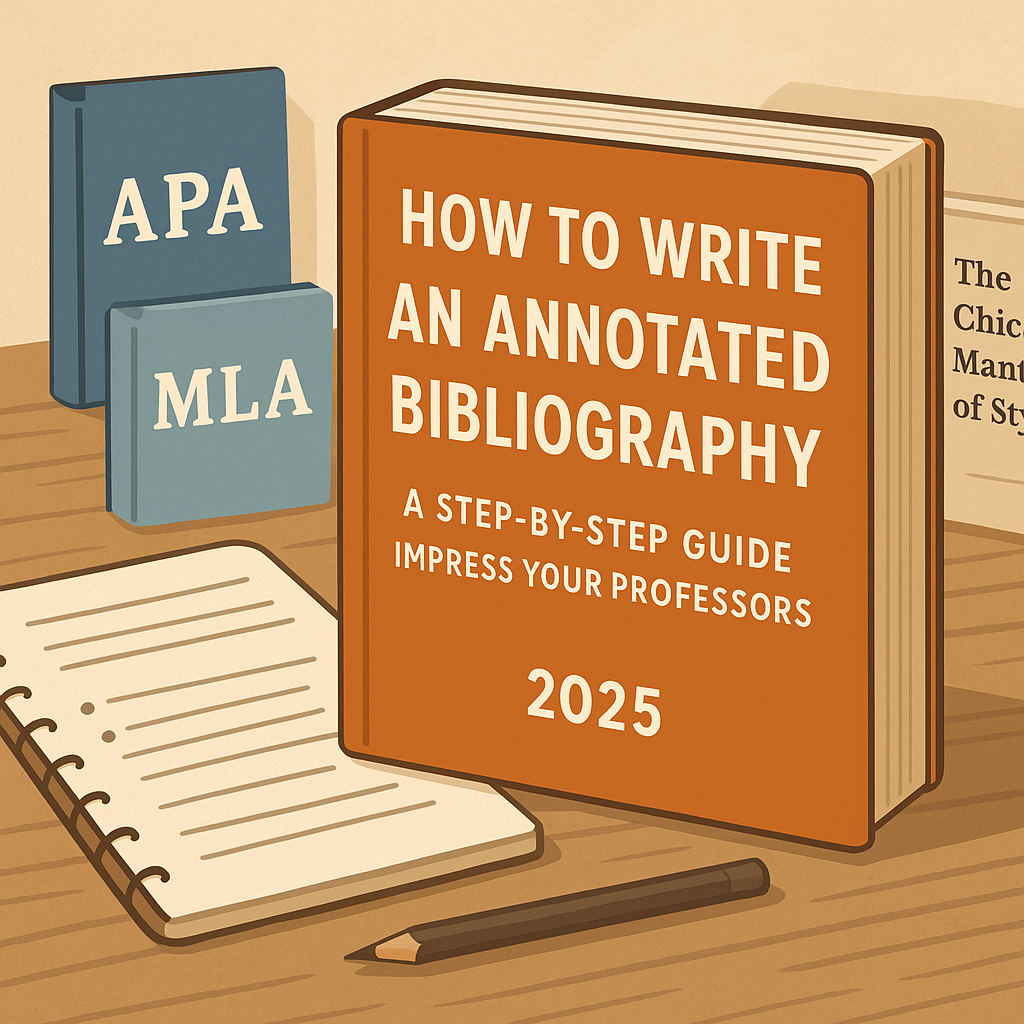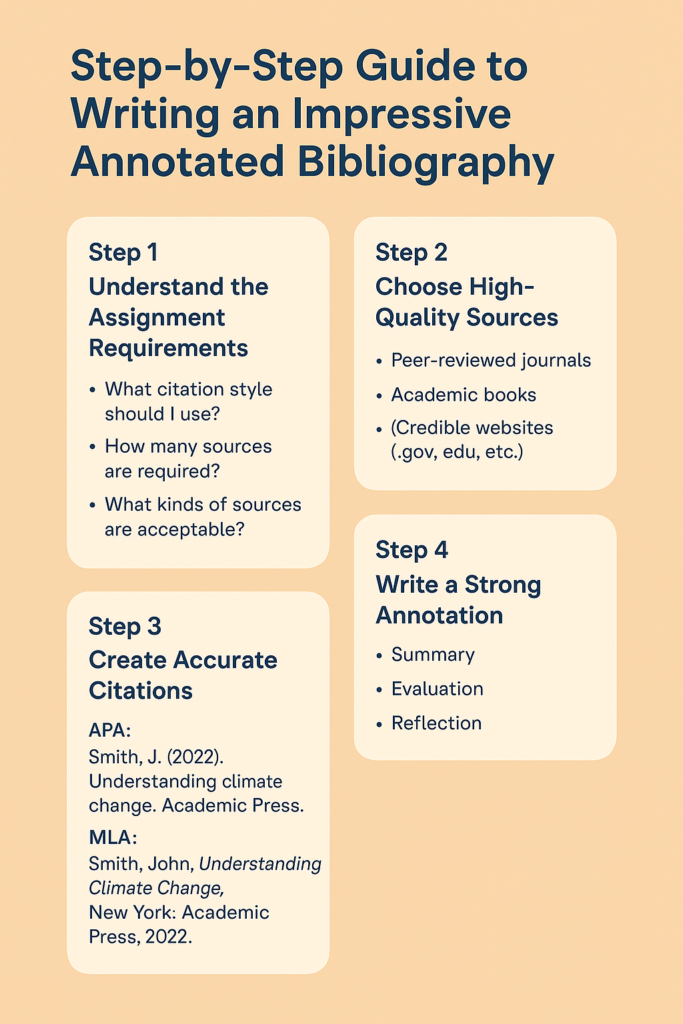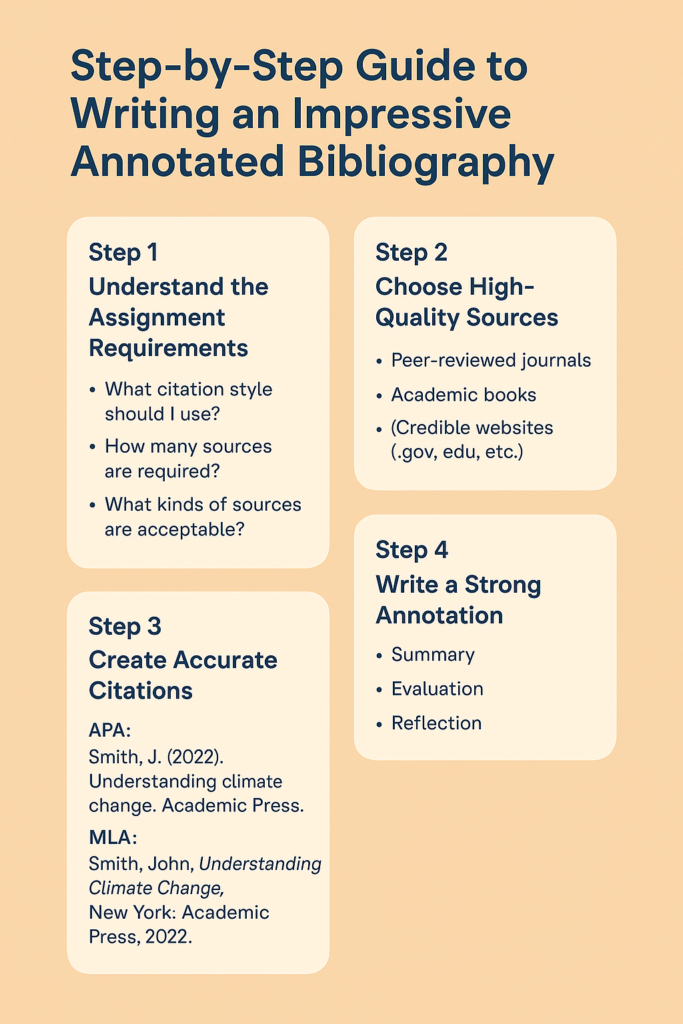Posted: May 13th, 2025
How to Write an Annotated Bibliography That Impresses Professors | Expert Guide 2025

Introduction
Annotated bibliographies are one of those academic assignments that seem simple on the surface—but crafting one that truly impresses your professor requires more than just listing your sources. It’s about showcasing your research skills, your understanding of the topic, and your ability to critically engage with scholarly material. Unlike a basic bibliography, an annotated bibliography includes a summary and evaluation of each source, demonstrating how it contributes to your overall research. This assignment challenges you to dig deeper: not only must you find credible academic sources, but you also have to analyze their relevance, reliability, and usefulness in relation to your research question or thesis.
A well-written annotation reflects your ability to synthesize information, identify key arguments, and even point out the strengths or limitations of each source. It also shows your professor that you’re not just collecting data—you’re thinking critically about your topic and building a solid foundation for future writing. In this comprehensive guide, we’ll break down how to write annotated bibliographies that stand out, covering everything from formatting to evaluation techniques. Whether you’re a freshman just getting started or a senior looking to polish your academic portfolio, this post will equip you with everything you need.
What Is an Annotated Bibliography?
Before we dive into the steps, let’s clarify what an annotated bibliography is.
An annotated bibliography is more than just a list of sources—it’s a curated collection of research materials that includes both citation and analysis. Each entry consists of two main parts: the citation and the annotation. The citation provides the full reference for the source, formatted according to a specific academic style such as APA, MLA, or Chicago. Following this is the annotation, which is a brief paragraph that summarizes, evaluates, and reflects on the source’s relevance to your research topic.
The goal of an annotated bibliography is to inform readers about the credibility, accuracy, and usefulness of each source. It helps you organize your research while also demonstrating your critical thinking skills. Whether you’re preparing for a research paper or building a literature review, annotated bibliographies are a valuable academic tool that show depth and scholarly engagement.
Why Do Professors Assign Annotated Bibliographies?
Professors assign annotated bibliographies to help students:
- Develop research skills.
- Learn how to assess the credibility and relevance of sources.
- Practice using citation styles.
- Engage with scholarly material more deeply.
- Lay the foundation for larger research papers.
If done well, an annotated bibliography reflects critical thinking, organization, and a deep understanding of your subject.
Step-by-Step Guide to Writing an Impressive Annotated Bibliography

Creating an annotated bibliography that truly impresses your professor involves more than just listing citations and adding a short paragraph. It requires strategic planning, critical thinking, and attention to detail. In this step-by-step guide, we’ll walk you through each phase of the process to help you create a polished and professional annotated bibliography.
Step 1: Understand the Assignment Requirements
Before you even begin your research, take time to thoroughly understand the requirements of the assignment. Many students lose valuable marks simply because they misunderstood or overlooked key expectations.
Start by asking yourself the following questions:
- What citation style is required? Is it APA (American Psychological Association), MLA (Modern Language Association), or Chicago Manual of Style? Each has distinct formatting rules and standards. Using the wrong style or mixing them can significantly impact your grade.
- How many sources are required? Your professor may ask for a minimum number of sources—typically 5 to 10 for short assignments, and more for extensive research projects. Always clarify if the total count includes both primary and secondary sources.
- What kinds of sources are acceptable? Some professors may only allow peer-reviewed journal articles or scholarly books, while others might accept credible websites, documentaries, or newspaper articles. Understanding the difference between primary sources (e.g., historical documents, firsthand interviews) and secondary sources (e.g., journal articles analyzing primary data) is also crucial.
- What should the annotation include? Some instructors only require a summary, while others expect a full evaluation and personal reflection. Read the rubric or assignment brief carefully—does it specify components like the source’s credibility, usefulness, or connection to your thesis?
If any of these points are unclear, don’t hesitate to ask your professor. Clarifying expectations at the start can save hours of confusion later and show your initiative as a serious student.
Step 2: Choose High-Quality, Relevant Sources
Your annotated bibliography is only as valuable as the sources it includes. Rather than grabbing the first few links from a Google search, invest time in gathering credible, scholarly materials. Professors will notice the quality of your research—and they’ll grade accordingly.
Here’s how to identify strong sources:
Use Academic Databases:
Rely on trusted academic databases such as:
- JSTOR
- Google Scholar
- PubMed
- Academic Search Premier
- Project MUSE
- Your university’s digital library portal
These platforms filter out unreliable content and give you access to peer-reviewed, scholarly research.
Prioritize Scholarly Works:
Look for:
- Peer-reviewed journal articles
- University press books
- Reports from research institutes or government bodies
- Official publications by respected organizations (e.g., WHO, United Nations)
Avoid sources that lack credibility such as:
- Blogs
- Personal opinion websites
- Wikipedia (while useful for background reading, it’s not a reliable academic source)
- Social media posts
Ensure Relevance and Recency:
Choose sources that are directly related to your topic and, when applicable, recent enough to reflect current research. This is especially important in fast-evolving fields like technology, medicine, or politics.
Pro Tip: Create a shortlist of potential sources, skim the abstracts or introductions, and narrow down based on depth, relevance, and credibility.
Step 3: Create Accurate Citations
Now that you’ve selected your sources, it’s time to format them correctly. Citations are the backbone of your annotated bibliography, and errors here can significantly hurt your final grade.
Below are examples of how to format citations in the three most common academic styles:
APA (7th Edition)
Smith, J. (2022). Understanding climate change. Academic Press.
MLA (9th Edition)
Smith, John. Understanding Climate Change. Academic Press, 2022.
Chicago (Notes and Bibliography Style)
Smith, John. Understanding Climate Change. New York: Academic Press, 2022.
Tips for Perfect Citations:
- Double-check punctuation and italics. Small mistakes add up quickly.
- Use the latest edition of each style guide. Citation rules change over time—APA and MLA have both seen major updates in recent years.
- Avoid over-reliance on citation generators. Tools like EasyBib and Citation Machine can be helpful, but they often misinterpret source metadata. Always verify the final format manually.
- Consult official guides like the Purdue OWL (Online Writing Lab) or your university’s writing center.
Step 4: Write a Strong, Well-Structured Annotation
The annotation is the heart of your bibliography. It’s where you show your ability to synthesize information, assess quality, and explain relevance. Each annotation should typically be 150–250 words, though some assignments may require more detail.
Your annotation should include the following elements:
1. Summary
Start by briefly summarizing the source. What is it about? What are the main arguments or findings?
Example:
In this comprehensive text, Smith explores the causes and consequences of climate change, emphasizing the role of human activity in accelerating environmental degradation.
2. Evaluation
Next, assess the source’s quality. Consider the author’s credentials, the publication’s credibility, and the methodology used.
Example:
Smith, a climatologist with over 20 years of experience, supports his arguments with recent studies and credible statistics. The book is published by Academic Press, a well-respected academic publisher.
3. Reflection
Finally, reflect on how the source is relevant to your research. How will it help you develop your argument or support your thesis?
Example:
This source is highly relevant to my research on environmental policy because it outlines the scientific basis for proposed regulations. I plan to use Smith’s data in the literature review section of my paper to establish the urgency of climate intervention.
Sample Full Annotation (APA Style)
Smith, J. (2022). Understanding climate change. Academic Press.
In this comprehensive text, Smith explores the causes and consequences of climate change, emphasizing the role of human activity in accelerating environmental degradation. The book presents scientific data in an accessible way, making it suitable for both academic and general audiences. Smith, a climatologist with over 20 years of experience, supports his arguments with recent studies and credible statistics.
This source is highly relevant to my research on environmental policy because it outlines the scientific basis for proposed regulations. I plan to use Smith’s data in the literature review section of my paper to establish the urgency of climate intervention.
Bonus Tips for Impressive Annotations:
- Use formal academic language. Avoid slang or overly casual expressions.
- Be objective. Avoid statements like “I liked this source.” Instead, focus on credibility and usefulness.
- Don’t overuse direct quotes. Summarize and paraphrase in your own words.
- Stick to the word limit. Brevity and clarity are key.
Best Practices for Writing Annotations That Shine

Crafting an effective annotated bibliography takes more than simply summarizing sources. It’s a chance to demonstrate your research skills, critical thinking, and understanding of academic material. Whether you’re writing for a class assignment or preparing a research project, following best practices can elevate your work from basic to brilliant. Here’s a comprehensive guide to help you write annotations that not only shine but also impress your professors.
1. Be Concise but Informative
Annotations are typically brief, ranging from 150 to 250 words per entry, but that doesn’t mean they should be superficial. Each annotation should provide meaningful insights into the source you’re referencing. Avoid simply restating the abstract or summary. Instead, synthesize the content in your own words to show that you truly understand the material. This means highlighting the main arguments, methodologies, and conclusions of the work.
While being informative, avoid redundancy or filler language. Use your word count wisely by focusing on the most relevant and impactful aspects of the source. For example, if a study uses a unique research method or provides groundbreaking results, mention that. This demonstrates your ability to evaluate and communicate complex ideas efficiently—an essential academic skill.
2. Use Clear, Academic, and Formal Language
Even though annotations are relatively short, treat them as formal academic writing. This means using complete sentences, avoiding contractions (e.g., use “does not” instead of “doesn’t”), and steering clear of slang or overly casual phrasing. Think of each annotation as a mini-essay: it should have structure, flow, and clarity.
Use academic vocabulary where appropriate, but avoid unnecessary jargon that may confuse your reader. Clarity is key. You want your professors to understand your annotations without having to decode them. The goal is to show that you can communicate complex ideas clearly and effectively.
3. Stay Objective and Analytical
Annotations should reflect critical thinking, not personal preference. When evaluating sources, base your assessments on objective criteria such as the author’s credentials, the publication’s credibility, the validity of the methodology, and the relevance to your topic. Instead of writing “I liked this article,” say something like “This peer-reviewed article, authored by a recognized expert in the field, provides data-supported conclusions relevant to current debates on climate policy.”
This kind of objective tone shows that you’re evaluating the material based on scholarly merit, not personal feelings. Always keep in mind that your readers (especially professors) expect annotations to be rooted in evidence, not emotion.
4. Follow the Correct Formatting Guidelines
Formatting errors are one of the easiest ways to lose points on an assignment. Every citation style—APA, MLA, Chicago, etc.—has specific rules regarding how citations and annotations should be formatted. These include:
- Double-spacing throughout the entry
- Hanging indents for each citation
- Annotations starting on a new line after the citation
- Uniform font and margins
Make sure your formatting aligns with your assignment requirements or the style guide you’re using. If you’re unsure about a particular rule, consult the official manual or trusted university writing centers online.
Common Mistakes to Avoid
Avoiding common errors can make the difference between a mediocre bibliography and an excellent one. Be on the lookout for the following pitfalls:
- Incomplete or Incorrect Citations: A single misplaced comma can be a red flag for inaccuracy. Always compare your citations against the official style guide to ensure precision.
- Over-Summarizing Without Analysis: Many students focus too heavily on summarizing the source and forget to evaluate its strengths and weaknesses. Your professors want to see that you can critically assess a work, not just repeat its content.
- Relying on Unreliable Sources: Stick to scholarly books, journal articles, and reputable websites. Avoid sources like Wikipedia, personal blogs, or unverified opinion pieces. These don’t hold weight in academic writing.
- Inconsistent Formatting: Uniformity in formatting and length is essential. Inconsistencies can disrupt the professional appearance of your bibliography and distract from your content.
Tools to Make Your Life Easier
Several online tools can assist in streamlining the annotation process, but they should be used wisely:
- Zotero: A powerful, free reference manager that helps you collect, organize, and cite sources.
- Mendeley: Another reference manager with PDF annotation and collaboration features.
- Grammarly: Useful for checking grammar, clarity, and tone in your annotations.
- EasyBib or Citation Machine: Helps generate citations in multiple styles, but always double-check for accuracy.
- Google Scholar: An excellent database for finding credible, scholarly sources that often include citation formats.
While these tools are helpful, they are not substitutes for critical thinking. Always review their output carefully and ensure it aligns with your professor’s expectations.
Sample Annotated Bibliography Entry (MLA Style)
Jones, Sarah. Women in Medieval Literature. Oxford UP, 2021.
Jones explores the portrayal of women in European medieval literature, focusing on gender roles, power dynamics, and narrative control. She examines a range of texts from Chaucer to Christine de Pizan, offering a feminist lens through which to interpret the literature. The book is well-researched, includes extensive citations, and features a helpful glossary for unfamiliar terms.
As a professor of English literature at Oxford University, Jones brings authority and academic rigor to her analysis. Her work provides deep insight into the cultural contexts that shaped literary depictions of women during the Middle Ages.
This book will support my thesis on how medieval literature both reflected and influenced societal norms regarding women. I intend to use it to strengthen the historical framework of my paper and to offer a critical perspective on the representation of female characters.
Final Checklist Before Submission
Use this checklist to ensure your annotated bibliography is polished and ready for submission:
✅ Have I included the required number of sources?
✅ Are all citations formatted correctly in the required style?
✅ Are annotations informative, analytical, and concise?
✅ Did I proofread for grammar, consistency, and clarity?
✅ Is the entire document properly formatted (spacing, indents, etc.)?
Taking time to review your work ensures that small mistakes don’t detract from your overall effort. A careful, detail-oriented bibliography signals to your professor that you take academic writing seriously.
Conclusion: Impressing Professors Starts With Effort
Writing an annotated bibliography that impresses your professors isn’t just about checking boxes—it’s about demonstrating that you are a thoughtful, organized, and critical thinker. Every annotation is a chance to show your grasp of the research and your ability to engage with scholarly material.
Approach this task as a vital part of your academic growth. Take time to evaluate each source thoughtfully, write with clarity, and format meticulously. Your professors will notice the difference.
Expert paper writers are just a few clicks away
Place an order in 3 easy steps. Takes less than 5 mins.